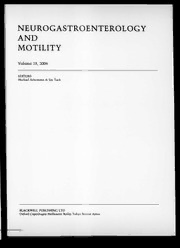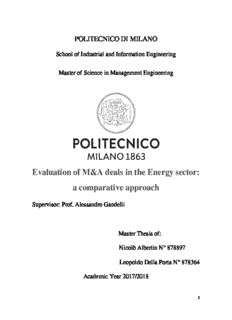
Evaluation of M&A deals in the Energy sector PDF
Preview Evaluation of M&A deals in the Energy sector
POLITECNICO DI MILANO School of Industrial and Information Engineering Master of Science in Management Engineering Evaluation of M&A deals in the Energy sector: a comparative approach Supervisor: Prof. Alessandro Gandelli Master Thesis of: Nicolò Albertin N° 878897 Leopoldo Della Porta N° 878364 Academic Year 2017/2018 1 Acknowledgements We both would like to thank our supervisor, Prof. Alessandro Gandelli, for the patient guidance, the inspiration and the advices he handed over throughout the writing of this research. It is harsh to express how lucky we feel, to have had a supervisor who cared so much about our work and our path, and who responded to our questions and queries so promptly. 2 3 TABLE OF CONTENTS 1. CHAPTER 1: INTRODUCTION…………………………………………………17 1.1. Brief history of oil…………………………………………………….………17 1.2. Oil Production………………………………………………………….….….19 1.3. OPEC production……………………………………………………….…….19 1.4. NON-OPEC production………………………………………………….…...23 1.4.1.1. China…………………………………………………….…….23 1.4.1.2. Russia………………………………………………….……...28 1.4.1.3. America……………………………………………….………33 1.5. Oil demand…………………………………………………………….……...34 1.6. Unconventional oil………………………………………………….………...35 1.6.1. Sand Oil……………………………………………………….……….35 1.6.2. Oil shale……………………………………………………….………36 1.6.3. Horizontal drilling…………………………………………….……….37 1.6.4. Hydraulic fracturing…………………………………………………...38 1.6.5. Shale 2.0……………………………………………………………….40 1.7. Innovative financing options in the oil and gas industry……………………..41 1.7.1. Banking sector…………………………………………………………41 1.7.2. Small cap explorers……………………………………………………42 1.7.3. Mid-to-large cap independents………………………………………...42 1.7.4. International oil companies………………………………………...….42 1.7.5. National companies…………………………………………………....43 1.7.6. Upstream and downstream infrastructure investments………………...43 1.7.7. Reserve-based lending…………………………………………………44 1.7.8. Project finance…………………………………………………………44 2. CHAPTER 2: M&A OPERATIONS………………………………………………47 2.1. Definition……………………………………………………………………...47 2.2. Types of M&A………………………………………………………………...47 2.2.1. Horizontal M&A……………………………………………………….48 4 2.2.2. Conglomerate operations………………………………………………48 2.2.3. Negotiation type………………………………………………………..49 2.2.4. Role in the acquisition…………………………………………………50 2.2.5. Friendly takeover………………………………………………………50 2.2.6. Hostile takeover………………………………………………………..50 2.2.7. Defensive tactics……………………………………………………….51 2.3. Motives for M&A……………………………………………………………..53 2.4. Disadvantages…………………………………………………………………56 2.5. Critical factor of unsuccess……………………………………………………57 2.6. Subjective motives for mergers and acquisition………………………………58 2.7. Waves…………………………………………………………………….……60 2.8. Literacy review………………………………………………………….….….64 2.8.1. Payment method…………………………………………………….….67 2.8.2. Acquisition type………………………………………………………..68 2.8.3. Level of debt……………………………………………………………68 2.8.4. Liquidity………………………………………………………………..69 2.8.5. Industry-relatedness…………………………………………………….69 2.8.6. Scale of the target company…………………………………………….69 3. CHAPTER 3: M&A IN ENERGY SECTOR………………………………………71 3.1. Context………………………………………………………………………...71 3.2. The trend of 2018………………………………………………………………72 3.3. Premium of transactions……………………………………………………….77 3.4. M&A deals by geographic region……………………………………………..78 3.5. Renewable energy sector………………………………………………………79 3.6. Outlook on main sectors………………………………………………………..81 3.7. Case study 1: Enel’s acquisition of Endesa…………………………………….83 3.8. Case study 2: ExxonMobil ‘s acquisition of XTO Inc. ……………………….106 3.9. Case study 3: Royal Dutch shell acquires BG………………………………...127 4. CHAPTER 4: M&A IN HOSPITALITY SECTOR……………………………….148 4.1. The Hospitality industry…………………………………………………...…148 5 4.2. Business models…………………………………………………………...…150 4.2.1. Leases……………………………………………………………...….151 4.2.2. Management agreements……………………………………..……….152 4.2.3. Franchise………………………………………………………………152 4.3. Industry overview…………………………………………………………….154 4.3.1. The global hotels landscape: cities……………………………………154 4.3.2. Hospitality in Europe…………………………………………………158 4.3.3. US growth drivers…………………………………………………….161 4.3.4. Chinese investments bonanza..……………………………………….162 4.4. M&A in hospitality…………………………………………………………..164 4.4.1. Wave 1: 1995-1997…………………………………………………...164 4.4.2. Wave 2: 2005-2007…………………………………………………...166 4.4.3. Wave 3: 2015-present…………………………………………………167 4.4.4. Motives for M&A……………………………………………………..170 4.4.4.1. Industry fragmentation………………………………………………………171 4.4.4.2. Geography…………………………………………………….172 4.4.4.3. Loyalty programs……………………………………………...173 4.4.4.4. Value drivers…………………………………………………..175 4.5. Case study 4: Marriott International acquires Starwood………………………177 4.6. Case study 5: Intercontinental Hotel Group acquires Kimpton Hotel & Restaurant Group Inc. ……………………………………………………………………198 4.7. Case study 6: AccorHotels acquires FRHI Group…………………………….220 5. CHAPTER 5: Analysis of M&A factors evidencing deal success………………...245 5.1. Energy sector: Analysis of the social implications………………...................247 5.1.1. Antitrust………………...………………...………………...…………247 5.1.2. Environment………………...………………...………………............259 5.2. Strategic determinants in the energy sector………………...…………………261 5.2.1. Royal Dutch Shell………………...………………...………………....262 5.2.2. ExxonMobil………………...………………...………………...……..265 6 5.2.3. Enel………………...………………...………………...……………...269 5.3. Strategic determinants in the Hospitality sector………………...……………269 5.4. Performance measurement………………...………………...………………..275 5.5. Energy performances………………...………………...………………...…...277 5.6. Hospitality performances…… 7 LIST OF FIGURES Chapter 1 Figure 1.1: OPEC proven oil reserves Figure 1.2: cumulative production and net additions, 2007-2016 Figure 1.3: OPEC-11 compliance with supply cuts in 2017 Figure 1.4: Russian liquid production divided per company output Figure 1.5: World Oil demand divided in OECD and NON-OECD countries Figure 1.6: illustration of hydraulic fracturing Figure 1.7: fracking liquid composition Figure 1.8: oil industry bonds emission by type in 2017 Chapter 2 Figure 2.1: M&A operations’ number and value worldwide for 1985-2017 Chapter 3 Figure 3.1: M&A operations in 2017 divided by sector Figure 3.2: M&A operations’ number and value in the energy sector worldwide for 1985-2017 Figure 3.3: bidder’s region of provenience in deals with target company in North America Figure 3.4: Average premium of the target company in M&A activities worldwide for 2006-2018 Figure 3.5: M&A activity worldwide divided for geographic appurtenance of the target Figure 3.6: target’s region of provenience in deals with bidder company in Europe Figure 3.7: Enel stock price after the acquisition Figure 3.8: Enel EBIT and Net earnings growth Figure 3.9: Enel operative data 8 Figure 3.10: Enel revenues segment for country of origin Figure 3.11: Enel’s return on equity, return on investment and leverage Figure 3.12: Enel’s liquidity ratios Figure 3.13: Enel’s debt coverage Figure 3.14: Enel’s debt structure Figure 3.15: Enel’s debt from banks Figure 3.16: Enel’s debt divided by currency Figure 3.17: ExxonMobil stock price after the acquisition Figure 3.18: ExxonMobil’s return on equity, return on investment Figure 3.19: ExxonMobil’s margins Figure 3.20: ExxonMobil’s crude oil production Figure 3.21: ExxonMobil’s natural gas production Figure 3.22: Shell stock price after the acquisition Figure 3.23: Shell’s margins on sales Figure 3.24: Shell’s liquidity ratios Figure 3.25: Shell’s leverage in selected years Chapter 4 Figure 4.1: North America vs European operating models in major hotel chains Figure 4.2: business models for selected hotel chains Figure 4.3: Mapping the world of hospitality Figure 4.4: Youth employment in hospitality sector in comparison to the overall economy Figure 4.5: GVA impact of hospitality sector Figure 4.6: 10-Year treasury rate Figure 4.7: Correlation between RevPAR growth rate and GDP growth rate 9 Figure 4.8: Share of the global market for hotel chains in 2016 Figure 4.9: Members of the reward program for hotel chain in 2016 Figure 4.10: Marriott stock price after the acquisition Figure 4.11: Marriott’s operating performances Figure 4.12: Marriott’s profit margins Figure 4.13: Marriott’s liquidity ratios Figure 4.14: Marriott’s debt analysis Figure 4.15: Marriott’s operating performances Figure 4.16: Marriott’s owned hotels in the world after Starwood integration Figure 4.17: Marriott’s European change in owned hotels Figure 4.17: IHG’ stock price after the acquisition Figure 4.18: IHG’ ROA decomposed Figure 4.19: IHG’s margins and number of employees Figure 4.20: IHG’s liquidity ratios Figure 4.21: IHG’s debt coverage ratios Figure 4.22: IHG’s debt structure Figure 4.23: IHG’s bank loans structure Figure 4.24: IHG’s bonds structure Figure 4.25: IHG’s debt divided by currency denomination Figure 4.26: IHG’s hotels and rooms worldwide Figure 4.27: IHG’s hotels and revenues Figure 4.28: AccorHotels stock price after the acquisition Figure 4.29: AccorHotels’ hotels and rooms worldwide Figure 4.30: AccorHotels’ profitability ratios Figure 4.31: AccorHotels’ operating margins 10
Description:The list of books you might like

Can’t Hurt Me: Master Your Mind and Defy the Odds

The Sweetest Oblivion (Made Book 1)

What Happened to You?

Haunting Adeline

DTIC ADA509405: Requirements for the Development of Bacillus Anthracis Spore Reference Materials Used to Test Detection Systems

Sur la taxinomie infragénérique du genre Phragmipedium (Orchidaceae)

Explaining Economic Backwardness: Post-1945 Polish Historians on Eastern Europe

Elizabeth City State University Catalog
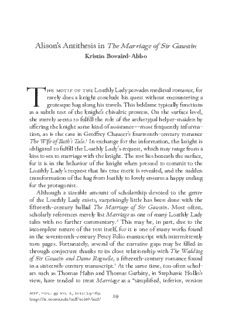
Alison's Antithesis in The Marriage of Sir Gawain

UFO Mail No 079 2006
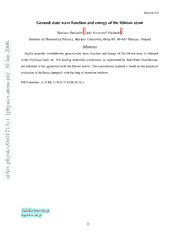
Ground state wave function and energy of the lithium atom

UFO Newsclipping Service 2006 04 no 441

Classical Horizons: The Origins of Sociology in Ancient Greece
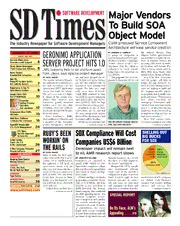
SD Times Issue 142

Verteilte Systeme: Grundlagen und Basistechnologien

DTIC ADA449059: On Generalized Authorization Problems

CA--LIFORNIA INSTITUTE

Avertissements Agricoles - Grandes cultures - Centre - 1993 - 13

Grundlagenforschung zur Entwicklung von umweltfreundlichen Schlacken für das Elektro-Schlacke-Umschmelzverfahren
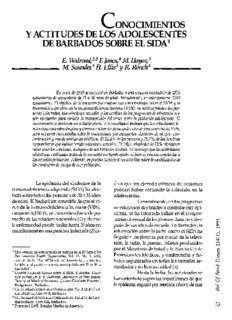
c onocimientos y actitudes de los adolescentes de barbados sobre el sida1

Norwich by E V Cole
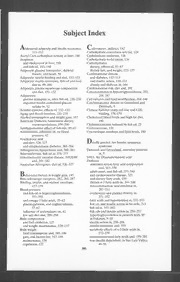
Annals of the New York Academy of Sciences 1993: Vol 683 Index

